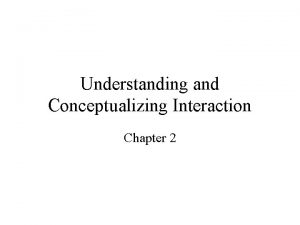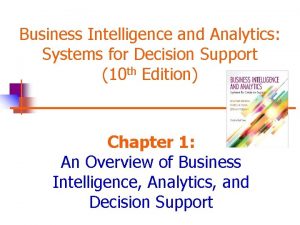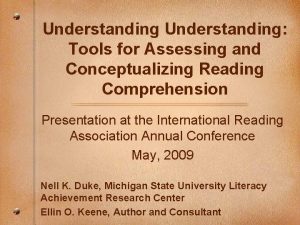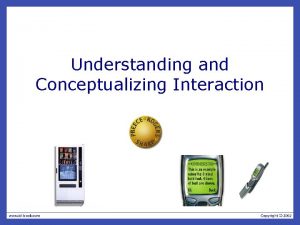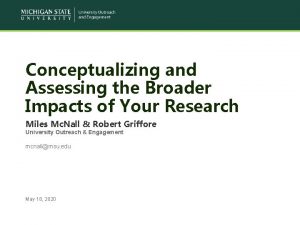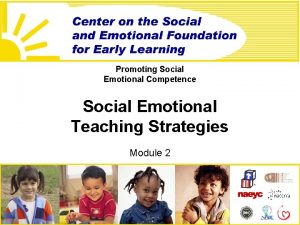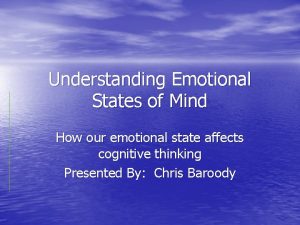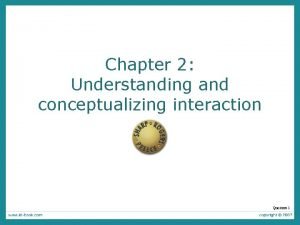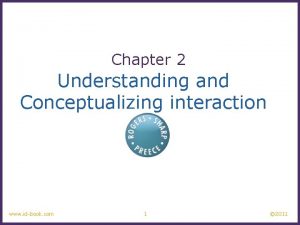Conceptualizing Assessing and Teaching Emotional Understanding in Clients
















- Slides: 16

Conceptualizing, Assessing, and Teaching Emotional Understanding in Clients with Personality Features of Autism, Asperger’s, and Nerds (PFAAN) Kenneth Smith, MS, MA, LPC Spirit of Peace Clinical Counseling, Ken. Therapy. com 2018 OCD Spring Conference

• Differences in Emotional Processing and Understanding 1 • Deductive vs Inductive Thinking of Emotions “Missing the [emotional] forest for the[emotion] tree Conceptualizing PFAAN: Personality Features or Disorder • Trouble with “just picking up” social dynamics 2 • Probably becoming harder to navigate social situations due to a more informal and online approach to social interactions 3 • Often marked anxiety surrounding social interactions • Women with Autism and PFAAN often much better at masking signs 4 • “Once one has learned to pay attention to the characteristic manifestations of autism, one realizes that they are not at all rare. ” Hans Asperger 5 © 2018 Kenneth Smith, MS, MA, LPC. Info at kentherapy. com

Assessing for Autism in Adult’s: Formal Assessment Autism Quotient(AQ) 6 • “Psychologist Simon Baron-Cohen and his colleagues at Cambridge's Autism Research Centre have created the Autism-Spectrum Quotient, or AQ, as a measure of the extent of autistic traits in adults…The test is not a means for making a diagnosis, however, and many who score above 32 and even meet the diagnostic criteria for mild autism or Asperger's report no difficulty functioning in their everyday lives. ” 7 • Free online version available at https: //www. aspietests. org/aq/index. php AQ-10 8 • A short and easy to administer form of AQ. A score of 6 or more suggests Autism. • The British NHS/University of Cambridge publishes a free version found at http: //docs. autismresearchcentre. com/tests/AQ 10. pdf 9 © 2018 Kenneth Smith, MS, MA, LPC. Info at kentherapy. com

§ An extensive checklist for aspects of Asperger’s in women created by Samantha Craft, author the book Everyday Asperger’s. Informal/Soft Assessment for PFAAN: Females & Asperger’s: A Checklist 13 § Not formally studied, but can give a clinician some ideas of what the more subtle signs of Asperger’s in females may look like. § Often I just give the client the checklist and have them go though it on their own and bring it back to therapy to discuss. § Can be found at https: //the-art-of-autism. com/females-andaspergers-a-checklist © 2018 Kenneth Smith, MS, MA, LPC. Info at kentherapy. com

• Is the person in a science, technology, engineering or math (STEM) career? • Does the person have intense interests (e. g. grammar, animals, sports stats, laws, science, etc. )? Informal/Soft Assessment for PFAAN: What to Look For To Consider PFAAN in Clients 1 • Ask them if they tend to have one emotion at a time. Or ask the client what they think if you told them that most people have more than one emotion at a time. • Sometimes the client may show too much empathy with others (more on this later). • Trouble recognizing non-verbal communication. Often have flat affect. • Sometimes have what seem to be narcissistic trait, but seem to want to understand others. • Many PFAAN clients think in pictures, not in words/emotions. 10 © 2018 Kenneth Smith, MS, MA, LPC. Info at kentherapy. com

Thinking in words/emotions vs pictures 1: What do you think about when you hear the word COW? Words and Emotions Thinking in Pictures © 2018 Kenneth Smith, MS, MA, LPC. Info at kentherapy. com

Many PFAAN clients have a deep sense of shame for having social and emotional challenges. Listen for things like: • • • My Perspective: PFAAN Personality Description Can Be Very Helpful to Client • “I’m broken”, “People tell me I’m creepy”, “People tell me I look like a school shooter” “Nobody gets or likes me. ” “I feel uncomfortable being touched and don’t know why” I am very scared of any social interactions I wish I was an animal (some may be very interested in depicting self as an animal or have an attraction to “furry” culture, often without any sexual overtones) Some may have shame that they have a very low sex drive • Learning about PFAAN gives clients insight • Having PFAAN means you speak a different emotional language/different brain structure than others, when client find that out it give them a chance to learn the other emotional language • Often formal diagnosis of Autism Spectrum Disorder is not necessary to be helpful to client. © 2018 Kenneth Smith, MS, MA, LPC. Info at kentherapy. com

My Perspective: PFAAN Personality Description Can Be Very Helpful to Client Often if you are not sure if a client has PFAAN, mention your suspicions and ask them to do research on his/her own about PFAAN/ASD. PFAAN clients often very good at searching out information about PFAAN features and can often tell you if they see themselves as having it. For most PFAAN clients finding out they have these features of personality is extremely well received and helpful, as compared to other diagnoses/personality features. Be aware that many people still associate Autism as a very severe disorder (often they mix it together with Intellectual Disability) so using PFAAN (or Asperger’s) terminology is helpful. © 2018 Kenneth Smith, MS, MA, LPC. Info at kentherapy. com

Feelings Wheel Concepts (created by Gloria Wilcox 11 with Addendums by Smith) The Feelings Wheel as a Visual and Dialectical Tool For Understanding the Emotions 1 • 6 Central/ Core Emotions • As you go farther out emotions more subjective and personal • Emotions that are next to each other more similar. Emotions opposite are opposite (dialectical). • Behaviors associated with emotions written on outside. • Divided into Thinking Emotions and Action Emotions. • This wheel only has natural emotions, not moral ones (e. g. shame, love, disgust) © 2018 Kenneth Smith, MS, MA, LPC. Info at kentherapy. com

AND vs. OR Emotional Processing 1 AND Emotions (Most people) OR Emotions (PFANN) © 2018 Kenneth Smith, MS, MA, LPC. Info at kentherapy. com

Mixing Feelings (“color”) together vs. Flipping Between Feelings 1 Most People Mix Emotional Colors PFAAN Clients Flip Between Emotional Colors (this can often make emotional processing take longer) © 2018 Kenneth Smith, MS, MA, LPC. Info at kentherapy. com

Using the Feelings Wheel to Teach Emotions/Empathy 1 • Help clients to label the emotions/emotional behaviors in self and others to be able to trace it back to the core emotion (core emotions tend to be easiest to understand). • Teach the behaviors appropriate to a emotional color family (e. g. what to do when other are sad). You might even have to teach them to smile, can use a mirror and pencil in the mouth technique (you can’t frown when you hold a pencil in your mouth). • Teach that most emotional communication is nonverbal and the client may have to clarify when confused about what another person is communicating. • Teach PFANN clients that most other people mix emotional colors together. • Teach PFANN clients that they will take a longer time to process emotions which is OK. PFANN clients may have to explain to others that it takes time to explore their feelings. © 2018 Kenneth Smith, MS, MA, LPC. Info at kentherapy. com

This Photo by Unknown Author is licensed under CC BY-NC-ND This Photo by Unknown Author is licensed under CC BY-NC ROLE PLAYING APPLICATION TIME! © 2018 Kenneth Smith, MS, MA, LPC. Info at kentherapy. com

© 2018 Kenneth Smith, MS, MA, LPC. Info at kentherapy. com

Copy of Feelings Wheel and This Presentation at http: //kentherapy. com/springoca 2018/ Readings Suggested Reading and Resources • Smith, Kenneth. (2017). Achieving a Better Understanding of Adult Autism. Counseling Today. September Issue, pgs. 54 -59. http: //kentherapy. com/achieving-a-better-understanding-of-adult-autism/ • The Way I See It by Temple Grandin • The Unwritten Rules of Social Relationships by T. Grandin and S. Barron • Connecting with Your Asperger Partner by Louise Weston Autism Quotient (AQ) and AQ-10 Online Resources • Online AQ at https: //www. aspietests. org/aq/index. php • PDF of AQ-10 at http: //docs. autismresearchcentre. com/tests/AQ 10. pdf © 2018 Kenneth Smith, MS, MA, LPC. Info at kentherapy. com

Citations (to prove I’m just not making everything up). 1. Smith, Kenneth (2017) Smith, Kenneth. (2017). Achieving a Better Understanding of Adult Autism. Counseling Today. September Issue, pgs. 54 -59. http: //kentherapy. com/achieving-a-better-understanding-of-adult-autism/ 2. Grandin, T. & Barron S. (2005) Unwritten Rules of Social Relationships. Future Horizons Inc. Arlington, TX. 3. Robison, J. E. (2008). Are computer and the Internet making people a little bit autistic? . Psychology Today. Accessed 3 -1 -18 at https: //www. psychologytoday. com/blog/my-life-aspergers/200811/are-computers-and-the-internet-making-people-little-bit-autistic 4. Mandy, W. & Steward R. (2016) Women with autism hide complex struggles behind masks. Spectrum. Accessed 3 -1 -18 at https: //spectrumnews. org/opinion/viewpoint/women-autism-hide-complex-struggles-behind-masks/ 5. Silberman, S. (2015). Neurotribes: The legacy of autism and the future of neurodiversity. Penguin. 6. Baron-Cohen, S. , Wheelwright, S. , Skinner, R. , Martin, J. , & Clubley, E. (2001). The autism-spectrum quotient (AQ): Evidence from Asperger syndrome/high-functioning autism, males and females, scientists and mathematicians. Journal of autism and developmental disorders, 31(1), 5 -17. 7. Autism Quotient (AQ) Online Test. Found at https: //www. aspietests. org/aq/index. php 8. Booth, T. , Murray, A. L. , Mc. Kenzie, K. , Kuenssberg, R. , O’Donnell, M. , & Burnett, H. (2013). Brief report: An evaluation of the AQ-10 as a brief screening instrument for ASD in adults. Journal of Autism and Developmental Disorders, 43(12), 2997 -3000. 9. University of Cambridge Autism Research Centre. (ND) AQ-10. Accessed 3 -1 -18 at http: //docs. autismresearchcentre. com/tests/AQ 10. pdf 10. Grandin, T. (2006). Thinking in pictures: And other reports from my life with autism. Vintage. 11. Willcox, G. (N. D) The Feeling Wheel. Accessed 3 -1 -18 at https: //med. emory. edu/excel/documents/Feeling%20 Wheel. pdf 12. Craft, S. (2016) Females and Asperger's: A Checklist. The Art of Autism Blog. Accessed 3 -1 -18 at https: //the-art-of-autism. com/femalesand-aspergers-a-checklist/ © 2018 Kenneth Smith, MS, MA, LPC. Info at kentherapy. com
 Conceptualization interaction
Conceptualization interaction Assessing grammar effectively
Assessing grammar effectively Secondary brand
Secondary brand Bi vs dss
Bi vs dss Web essentials clients servers and communication
Web essentials clients servers and communication Meaning of micro teaching
Meaning of micro teaching Philippine professional standards for teachers
Philippine professional standards for teachers Informal and formal assessment
Informal and formal assessment Assessing a new venture's financial strength and viability
Assessing a new venture's financial strength and viability Assessing leadership and measuring its effects
Assessing leadership and measuring its effects Many new drivers first fender bender is a backing collision
Many new drivers first fender bender is a backing collision Module 4 topic 1 assessing and managing risk
Module 4 topic 1 assessing and managing risk Todays public relations departments
Todays public relations departments Recruitment consultant cold calling script
Recruitment consultant cold calling script Principe de protection des clients
Principe de protection des clients étude de flux
étude de flux Typologie des clients insatisfaits
Typologie des clients insatisfaits
